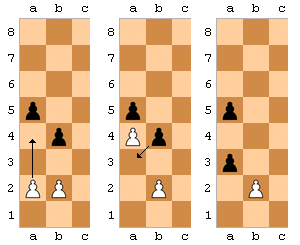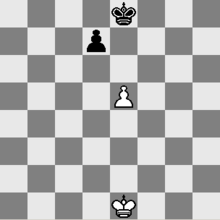En passant


En passant (from Template:Lang-fr) is a move in chess.[1] It is a special pawn capture, that can only occur immediately after a pawn moves two ranks forward from its starting position and an enemy pawn could have captured it had the pawn moved only one square forward. (The capturing pawn must be on its fifth rank prior to executing this maneuver.) The opponent captures the just-moved pawn "as it passes" through the first square. The resulting position is the same as if the pawn had moved only one square forward and the enemy pawn had captured it normally.
The en passant capture must be made at the very next turn or the right to do so is lost.[2] It is the only occasion in chess in which a piece is captured but is not replaced on its square by the capturing piece. Like any other move, if an en passant capture is the only legal move available, it must be made. En passant capture is a common theme in chess compositions.
The en passant capture rule was added in the 15th century when the rule that gave pawns an initial double-step move was introduced. It prevents a pawn from using the two-square advance to pass an adjacent enemy pawn without the risk of being captured.
A pawn on its fifth rank may capture an enemy pawn on an adjacent file that has moved two squares in a single move, as if the pawn had moved only one square. The conditions are:
- the capturing pawn must be on its fifth rank;
- the captured pawn must be on an adjacent file and must have just moved two squares in a single move (i.e. a double-step move);
- the capture can only be made on the move immediately after the opposing pawn makes the double-step move; otherwise the right to capture it en passant is lost.
|
Black to move
The black pawn is on its initial square. As in typical play, if it moves to f6 (marked by ×), the white pawn could capture it.
|
White to move
Black moved his pawn forward two squares in a single move from f7 to f5, "passing" f6.
|
Black to move
White captures the pawn en passant, as if it had moved only one square to f6.
| ||||||||||||||||||||||||||||||||||||||||||||||||||||||||||||||||||||||||||||||||||||||||||||||||||||||||||||||||||||||||||||||||||||
En passant is a unique privilege of pawns: pieces cannot capture en passant. It is the only occasion in chess in which the capturing piece does not replace the captured piece on its square.[3]: 463
Examples
In the opening
| a | b | c | d | e | f | g | h | ||
| 8 |  | 8 | |||||||
| 7 | 7 | ||||||||
| 6 | 6 | ||||||||
| 5 | 5 | ||||||||
| 4 | 4 | ||||||||
| 3 | 3 | ||||||||
| 2 | 2 | ||||||||
| 1 | 1 | ||||||||
| a | b | c | d | e | f | g | h | ||
There are some examples of en passant in chess openings. In this line from Petrov's Defence, White can capture the pawn on d5 en passant on his sixth move.
- 1. e4 e5
- 2. Nf3 Nf6
- 3. d4 exd4
- 4. e5 Ne4
- 5. Qxd4 d5 (diagram)
- 6. exd6e.p.[4]: 124–125
Another example occurs in the French Defense after 1.e4 e6 2.e5, a move once advocated by Wilhelm Steinitz.[5]: 2 If Black responds with 2...d5, White can capture the pawn en passant with 3.exd6. Likewise, White can answer 2...f5 with 3.exf6e.p.
| a | b | c | d | e | f | g | h | ||
| 8 |  | 8 | |||||||
| 7 | 7 | ||||||||
| 6 | 6 | ||||||||
| 5 | 5 | ||||||||
| 4 | 4 | ||||||||
| 3 | 3 | ||||||||
| 2 | 2 | ||||||||
| 1 | 1 | ||||||||
| a | b | c | d | e | f | g | h | ||
An example is from this game by Steinitz and Bernhard Fleissig.[6]
- 1. e4 e6
- 2. e5 d5
- 3. exd6e.p.
Unusual examples
Position after 12...f7–f5
|
After 14...g7–g5. White mates by taking the pawn en passant.
| ||||||||||||||||||||||||||||||||||||||||||||||||||||||||||||||||||||||||||||||||||||||||
Black has just moved his pawn from f7 to f5 in this game between Gunnar Gundersen and Albert H. Faul.[7] White could capture the f-pawn en passant with his e-pawn, but instead played:
- 13. h5+ Kh6
- 14. Nxe6+
Note that the bishop on c1 effects the check, via a discovered check. 14...Kh7 results in 15.Qxg7#.
- 14... g5
- 15. hxg6e.p.#
The en passant capture and discovered checks place Black in checkmate (from White's rook on h1, even without help from White's bishop; an en passant capture is the only way a double check can be delivered without one of the checking pieces moving, as in this position).
The largest known number of en passant captures in one game is three, shared by three games; in none of them were all three captures by the same player. The earliest known example is a 1980 game between Alexandru Sorin Segal and Karl Heinz Podzielny.[8]: 98–99 [9]
In chess compositions
| a | b | c | d | e | f | g | h | ||
| 8 |  | 8 | |||||||
| 7 | 7 | ||||||||
| 6 | 6 | ||||||||
| 5 | 5 | ||||||||
| 4 | 4 | ||||||||
| 3 | 3 | ||||||||
| 2 | 2 | ||||||||
| 1 | 1 | ||||||||
| a | b | c | d | e | f | g | h | ||
En passant captures have often been used as a theme in chess compositions, as they "produce striking effects in the opening and closing of lines".[10]: 106 In the 1938 composition by Kenneth S. Howard, the key move 1. d4 introduces the threat of 2.d5+ cxd5 3.Bxd5#. Black may capture the d4-pawn en passant in either of two ways:
- The capture 1... exd3e.p. shifts the e4-pawn from the e- to the d-file, preventing an en passant capture after White plays 2. f4. To stop the threatened mate (3.f5#), Black may advance 2... f5, but this allows White to play 3. exf6e.p.# with checkmate due to the decisive opening of the e-file.
- If Black plays 1... cxd3e.p., White exploits the newly opened a2–g8 diagonal with 2. Qa2+ d5 3. cxd6e.p.#
| a | b | c | d | e | f | g | h | ||
| 8 |  | 8 | |||||||
| 7 | 7 | ||||||||
| 6 | 6 | ||||||||
| 5 | 5 | ||||||||
| 4 | 4 | ||||||||
| 3 | 3 | ||||||||
| 2 | 2 | ||||||||
| 1 | 1 | ||||||||
| a | b | c | d | e | f | g | h | ||
An example showing the effect en passant captures have on pins is this 1902 composition by Sommerfeldt:[11]
The key move 1. d4! threatens 2. Qf2#. The black e-pawn is now simultaneously pinned and unpinned, as 1... exd3e.p.+ is illegal, but 1... e3+ is not. This however removes the black king's access to e3, allowing 2. d5#.
Historical context
Allowing the en passant capture, together with the introduction of the two-square first move for pawns, was one of the last major rule changes in European chess, and occurred between 1200 and 1600. Other relatively recent rule changes were castling, the unlimited range for queens and bishops[12]: 14, 16, 57 (Spanish master Ruy López de Segura gives the rule in his 1561 book Libro de la invencion liberal y arte del juego del axedrez[13]: 108 ) and a change to the rules on pawn promotion. In most places the en passant rule was adopted at the same time as allowing the pawn to move two squares on its first move, but it was not universally accepted until the Italian rules were changed in 1880.[4]: 124–125
The motivation for en passant was to prevent the newly added two-square first move for pawns from allowing a pawn to evade capture by an enemy pawn.[12]: 16 Asian chess variants, because of their separation from European chess prior to that period, do not feature any of these moves.
Notation
In either algebraic or descriptive chess notation, en passant captures are sometimes denoted by "e.p." or similar, but such notation is not required. In algebraic notation, the capturing move is written as if the captured pawn advanced only one square, for example, bxa3 (or bxa3e.p.) in this example.[13]: 216
Threefold repetition and stalemate
The possibility of an en passant capture is relevant to claims of a draw by threefold repetition. Two positions whose pieces are all on the same squares, with the same player to move, are for this purpose considered different if there was an opportunity to make an en passant capture in the first position, and of course that opportunity no longer exists the second time the same configuration of pieces occurs.[14]: 27
In his book on chess organization and rules, International Arbiter Kenneth Harkness wrote that it is frequently asked if an en passant capture must be made if it is the only legal move.[15]: 49 This point was debated in the 19th century, with some arguing that the right to make an en passant capture is a "privilege" that one cannot be compelled to exercise. In his 1860 book Chess Praxis, Howard Staunton wrote that the en passant capture is mandatory in that instance. The rules of chess were amended to make this clear.[8] Today, it is settled that the player must make that move (or resign). The same is true if an en passant capture is the only move to get out of check.[15]: 49
See also
References
Notes
- ^ Brace, Edward (1977), "en passant", An Illustrated Dictionary of Chess, Secaucus, N.J: Craftwell, ISBN 1-55521-394-4
- ^ FIDE rules (En Passant is rule 3.7, part d)
- ^ Burgess, Graham (2000), The Mammoth Book of Chess (2nd ed.), New York: Carroll & Graf, ISBN 978-0-7867-0725-6
- ^ a b Hooper, David; Whyld, Kenneth (1992), "en passant", The Oxford Companion to Chess (2nd ed.), Oxford: Oxford University Press, ISBN 0-19-866164-9
- ^ Minev, Nikolay (1998), The French Defense 2: New and Forgotten Ideas, Davenport, Iowa: Thinkers' Press, ISBN 0-938650-92-0
- ^ Steinitz vs. Fleissig, 1882
- ^ Gundersen vs. Faul. ChessGames.com. Retrieved on 2009-06-12.
- ^ a b Winter, Edward (1999), Stalemate, Chesshistory.com, retrieved 2009-06-12
- ^ A. Segal vs. K. Podzielny, Dortmund 1980. Published by 365Chess.com. Retrieved on 2009-12-05.
- ^ Howard, Kenneth S. (1961), How to Solve Chess Problems (2nd ed.), Dover, ISBN 978-0-486-20748-3, retrieved 2009-11-30
- ^ Open chess diary by Tim Krabbé - #234
- ^ a b Davidson, Henry (1949), A Short History of Chess (1981 paperback ed.), McKay, ISBN 0-679-14550-8
- ^ a b Golombek, Harry (1977), "en passant, capture", Golombek's Encyclopedia of Chess, Crown Publishing, ISBN 0-517-53146-1
- ^ Schiller, Eric (2003), Official Rules of Chess (2nd ed.), Cardoza, ISBN 978-1-58042-092-1
- ^ a b Harkness, Kenneth (1967), Official Chess Handbook, McKay, ISBN 1-114-15703-1
Bibliography
- Just, Tim; Burg, Daniel B. (2003), U.S. Chess Federation's Official Rules of Chess (5th ed.), McKay, ISBN 0-8129-3559-4
- Winter, Edward (2006), Chess Facts and Fables, McFarland, ISBN 0-7864-2310-2
